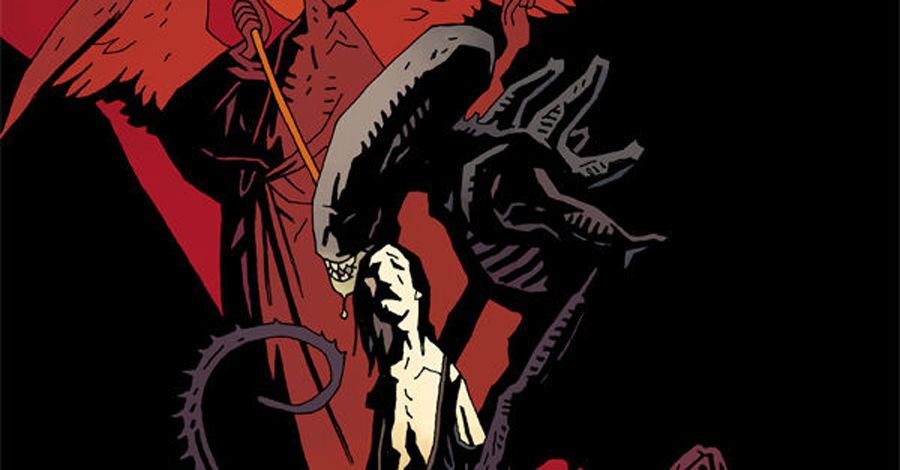It would be an exaggeration to say Dark Horse saved this 22-year-old Aliens one-shot from obscurity by re-publishing it in a slick, if slim, new hardcover, although it's tempting to do so, if only for the play on words.
In reality, re-releasing Aliens: Salvation in this nice, standalone, bookshelf-ready format probably has as much to do with putting out one more book with Mike Mignola's name on the spine as making sure that one of the better-looking, more idiosyncratically designed Aliens tie-ins is readily available.
The fact that it's back in print and on shelves this week is more important than the how and why of it, though.
It's penciled by Mignola, who also drew the original cover as well as what appears to be a new one (in his current, even more stripped-down style), from a script by Dave Gibbons. It's inked by Kevin Nowlan, colored by Matt Hollingsworth and lettered by Clem Robins.
Salvation first saw print in 1993, the same year Mignola's signature creation Hellboy, and has been collected two other times: first in 2001, as one half of the trade Aliens: Salvation and Sacrifice, and then again in 2003, in Aliens Omnibus Vol. 3. This third, and likely final, collection seems rather perfectly poised to capitalize on Mignola's popularity.
It contains the most basic elements of the original Alien horror story -- the alien, the evil corporation, the chest-bursting, the character that is secretly a robot -- as well as innovations that appeared in the first sequel, like the queen, the egg-laying and the blazing guns. The thoroughly lived-in, barely futuristic future is again the setting, although here the location is a jungle that seems more natural for the Aliens' perennial foils, the Predators.
The crew of the space freighter Nova Maru is hauling a mysterious cargo that, once it's released, causes the ship's captain to go pretty crazy, forcing religious cook Selkirk to pilot the escape pod to the nearest planet.
You know what that cargo is, right? The two to survive on the inhospitable jungle island for a while, but eventually the ship they escaped from crashes near them, and that killer cargo gets loose and starts doing what it does.
Selkirk is a rather devout Christian, thanking God for every good thing that happens to him, assigning responsibility for even the bad stuff to God, and stopping regularly to pray. He thinks of a female crew member who saves him as an angel, and the Aliens as demons. Gibbons' narration for Selkirk is definitely, strictly Christian, although general enough that it can't be narrowed down to a particular denomination. Interesting that the faith survives as it does into the future of Aliens, though.
Gibbons' narration never quite becomes tedious, but it certainly gets predictable, and while Selkirk's ultimate realization of what the real, true evil in the universe is won't surprise anyone who's seen any of the movies or read many of the comics, it's still rather elegantly conveyed.
The scripting is fine, then. Good if not great, providing a perfectly serviceable franchise story that tries to tell the basic Aliens story while finding a new, unexplored route, if never quite transcending its origins. Gibbons also puts the fact that readers will be at least one step ahead of all the characters to good use, showing the results of particular actions without needing to depict them.
The art, on the other hand, is really rather special. The Mignola of 1993 isn't the same Mignola of 2003 or 2013 exactly, but he's awfully close, and this is quite clearly the work of the Hellboy artist, perfectly paired with an inker.
Their Aliens are rather lovely, with Mignola's reduction of the subject matter into basic forms losing the slimy, wriggly, baroque detailing of designer H.R. Giger's originals, while clearly depicting the same creatures in a colder, starker, blockier form that makes them seem even more alien. Mignola and Nowlan's Aliens don't seem to belong in the world of metal that the humans live in, nor in the organic world of rock and plants and water of the planet. They're something between organic and machine, an appropriate look for living killing machines, right?
Every few pages brings a new stop-stand-stare panel: a horrifying dream sequence that prefigures some of Mignola's trippier Hellboy scenes, the way Aliens caught in an explosion float in its force and start to dissolve around the edges, the beautiful corpses with perfectly symmetrical exit wounds in their chests that look like objets d'arte more than Alien victims, the body horror of one of those realistic robot people with its face burnt off and its gory artificial guts spilling out, and on and on.
I don't know that this is the best of Dark Horse's Aliens comics or anything, but it's certainly one that deserves revisiting, and this nice, new packaging provides the opportunity to do just that.

